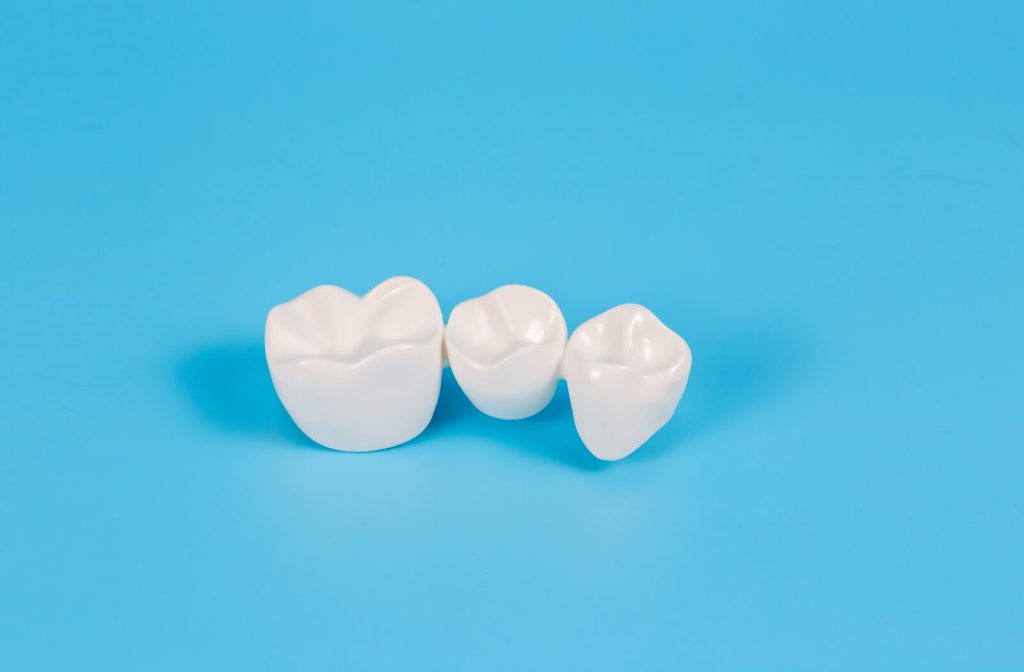Cosmetic dentistry is the practice of improving the appearance and sometimes function of your teeth. Cosmetic dentistry procedures repair chipped or broken teeth and enhance the colour, shape, position, size, and alignment of your teeth.
Dental procedures like veneers and crowns can help people gain confidence in their smiles and treat oral health conditions like cracked teeth. But what’s the difference between cosmetic solutions, and how can a dentist help you find the right one to reach your smile goals?
Veneers vs Crowns is More Than Just Cosmetic
Cracked, chipped, and broken teeth don’t just affect how your smile looks but can lead to other oral health issues. Your teeth are made of multiple layers, each playing an important role. The ordinarily white, hard outer layer of your teeth is called the enamel.
Your enamel is the hardest substance in your body—in fact, it ranks at a 5 on the Mohs hardness scale, putting it at the same level as steel in terms of strength. Enamel protects the important inner layer of your teeth called the dentin. Dentin contains vital blood vessels and nerves and helps you control how hard you chew while eating.
If the dentin is left exposed from cracked or broken teeth, it can interfere with your dentin and be dangerous, especially as it becomes more difficult to gauge your bite. Cosmetic solutions like veneers and crowns leave your smile looking the way you want it to, but they also serve an essential role in protecting your teeth.
What are Veneers?
Veneers are thin shells made of porcelain made to fit your teeth. Veneers are ideal for people who want to improve their smile’s appearance. Since veneers are individually created to fit over your teeth, you can use them to get your desired colour or shape.
Your dentist is an ideal resource to help you find the right cosmetic solution. They’ll discuss your specific needs and recommend a method based on your goals. Veneers may not be an option for you if:
- You have untreated gum disease
- You don’t have enough enamel
- Too much of the tooth is missing
- You grind your teeth
Procedure for Veneers
To create your veneers, your dentist first removes a small amount of enamel. Afterward, your dentist carefully makes a mould of your tooth surface. Removing the enamel ensures your veneers will fit comfortably onto your existing teeth.
Creating veneers usually takes at least 2 dental appointments. After the first appointment, where your dentist makes the mould of your teeth, they’ll usually fit you with temporary veneers to protect your teeth while a lab makes your permanent ones.
During your next appointment, your dentist will texture your enamel to ensure your veneers stick well to the front of your teeth. Veneers are then glued to your tooth surface one by one using dental cement.
Often, your dentist will recommend you get more than one veneer, so your teeth appear consistent. The most common teeth for veneers are the top-middle 6–8 teeth.

What are Crowns?
Dental crowns are artificial teeth shaped to align with your existing teeth. A dental crown is an option for teeth that are cracked or damaged and require more drastic repairs than can be covered with veneers.
Crowns may be an option if you have:
- Severely cracked teeth
- Significant tooth decay
- A large tooth filling
Your dentist can make a crown from several materials, including porcelain, metal, ceramic, and composite resin. The material used depends on the crown’s placement and how often it is used in your bite.
For example, metal crowns are suitable for molars because metal is hard and good for chewing, and the colour isn’t as significant since molars sit at the back of your mouth. Your incisors, usually located at the front of your smile, are more suited to porcelain since appearance matters more.
Procedure for Crowns
To prepare your tooth for a crown, your dentist first removes any decay and reshapes your tooth into a dome-like shape. This dome shape is what your crown will eventually sit on. Your dentist will then take measurements of your bite to ensure the crown fits seamlessly into your smile.
While waiting for the lab to create your permanent crown, your dentist will create a temporary crown out of plastic or metal. During your next appointment, your dentist will fit the permanent crown and make adjustments to ensure it is comfortable and works well with your existing teeth.
Find the Right Solution for You
Veneers and crowns are both effective treatments for cracked teeth that benefit from improving your smile if you need it. While veneers are a thin shell covering the front surface of your teeth, crowns sit directly on top of your tooth and are usually an option if your tooth is more damaged or decayed.
Whether you’re looking for a solution like crowns and veneers or something even more permanent like implants and dental bridges, your Mississauga dentist at Van Mills Dental can help you find the ideal cosmetic procedure.


